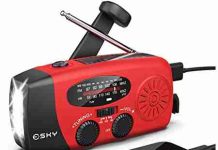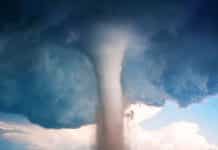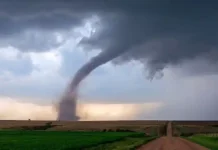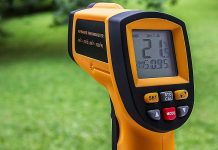When it comes to fishing, many factors can affect your chances of success. One of the most important of these is barometric pressure.
This is the weight of the air pressing down on everything on the planet, including fish and anglers.
Changes in barometric pressure can significantly impact fish behavior, and understanding these changes can help you improve your chances of catching something.
So what is the best barometric pressure for fishing? The answer is not simple, as different fish species can have different preferences.
However, some general guidelines can help. As a rule of thumb, many anglers prefer to fish when the barometric pressure is stable or rising rather than falling.
This is because falling pressure can indicate a storm or other weather system moving in, which can cause fish to become less active.
Understanding Barometric Pressure
Barometric pressure, or atmospheric pressure, is the weight of the air pressing down on the earth’s surface.
The pressure is measured using a barometer, which can be calibrated in different units such as inches of mercury (inHg) or millibars (MB). The standard atmospheric pressure at sea level is 29.92 inHg or 1013.25 mb.
Barometric pressure can fluctuate due to changes in weather patterns or altitude. As the pressure drops, it indicates that a low-pressure system is moving in, which often brings rain and storms.
Conversely, a rising barometer indicates a high-pressure system is moving in, often bringing clear skies and calm weather.
In fishing, barometric pressure can affect the behavior of fish. While there is no one-size-fits-all answer to the best barometric pressure for fishing, it is generally believed that a normal barometric pressure between 29.70 and 30.40 inHg is optimal.
During high-pressure systems with clear skies, fish bite slowly and are often found in deep water or near cover. During low-pressure systems with storms or rain, fish tend to be more active and can often be found in shallower waters.
It’s important to note that barometric pressure is just one-factor affecting fishing success. Other factors, such as water temperature, wind direction, and time of day, can also play a significant role.
Using a barometer to track barometric pressure fluctuations can help predict fish behavior and improve fishing success.
Overall, understanding barometric pressure and its effect on fish behavior can be a valuable tool for any angler looking to improve their fishing skills.
Barometric Pressure and Fish Behavior
Barometric pressure plays a significant role in fish behavior, and understanding this relationship is crucial for successful fishing.
Fish have a physiological system called a swim bladder that helps them maintain buoyancy. This swim bladder is filled with gas, and changes in atmospheric pressure can affect its size, causing fish to move up or down in the water column.
When the barometric pressure is high, fish tend to be less active and stay closer to the bottom. As the pressure drops, fish become more active and move toward the surface. This is because the decrease in pressure causes the swim bladder to expand, making it easier for fish to swim at higher depths.
On the other hand, when the barometric pressure is low, fish tend to become less active and move toward deeper waters. This is because the decrease in pressure causes the swim bladder to contract, making it harder for fish to maintain buoyancy and swim at higher depths.
Fish also have pressure-sensing systems that help them detect changes in pressure. These systems allow fish to adjust their behavior accordingly, such as feeding more actively when the pressure drops.
It’s essential to note that not all fish species react the same way to changes in barometric pressure. Some species, such as bass, tend to be more active during falling barometric pressure, while others, such as trout, may become more active during rising pressure.
In conclusion, understanding how barometric pressure affects fish behavior is crucial for successful fishing. Keeping track of changes in barometric pressure and adjusting fishing techniques can increase the chances of a successful catch.
Camco TRAC Outdoors Fishing Barometer | Features an Adjustable Pressure Change Indicator with Reference Marker & Color-Coded Dial | Easily Calibrates to Local Barometric Pressure (69200)
$24.00 in stock
La Crosse Technology 308-1451 Atomic Forecast Station with Fisherman Icon, In/Out Temperature, Humidity, Barometer, Sunrise/Sunset, Dual Alarms
$42.39 in stock
Wall Hanging 3 in 1 Barometer Weather Station,132mm Barometer Thermometer Hygrometer Barometric Pressure Gauge for Indoor and Outdoor Use,No Battery
Fishing Techniques and Gear for Different Barometric Pressures
When it comes to fishing, barometric pressure can significantly impact the behavior of fish.
We must adjust our fishing techniques and gear according to the barometric pressure to increase our chances of success. Here are some tips for fishing in different barometric pressures:
High Pressure
Fish tend to be more passive and less active when the barometric pressure is high. We must slow down our fishing techniques and use lighter tackle to catch fish in these conditions. Here are some techniques that work well in high-pressure conditions:
- Drop Shot Rig: This rig works well for bass, trout, and crappie. It involves using a small hook with a weight at the bottom and a bait or lure above the weight. The weight sits on the bottom, and the bait or lure floats above it. This technique lets us naturally present our bait or lure and entice fish to bite.
- Jigging: Jigging works well for walleye and other bottom-dwelling fish. It involves using a jig with a weighted head and a hook with a bait or lure attached. We drop the jig to the bottom and lift it up and down in a jerking motion to entice the fish to bite.
Low Pressure
Fish tend to be more active and aggressive when the barometric pressure is low. We must use more aggressive fishing techniques and heavier tackle to catch fish in these conditions. Here are some techniques that work well in low-pressure conditions:
- Topwater Fishing: This technique uses lures that float on the water’s surface. We can use poppers, buzz baits, or other topwater lures to entice fish to bite. This technique is particularly effective for bass and other predatory fish.
- Spinnerbaits: Spinnerbaits are versatile lures used in various fishing conditions. They consist of a weighted head and a spinner blade that rotates as we retrieve the lure. We can use different colors and sizes of spinnerbaits to target different types of fish.
Medium Pressure
When the barometric pressure is in the medium range, fish tend to be more active but not as aggressive as in low-pressure conditions. This is an excellent time to test different lures, baits, and techniques to see what works. Here are some techniques that work well in medium-pressure conditions:
- Crankbaits: Crankbaits are lures that imitate the movement of prey fish. They have a diving lip that causes the lure to dive into the water when we retrieve it. We can use different colors and sizes of crankbaits to target different types of fish.
- Texas Rig: The Texas rig is versatile and can be used with various baits and lures. It involves using a bullet weight and a hook with a bait or lure attached. We can use different types of baits and lures with the Texas rig to target different types of fish.
Adjusting our fishing techniques and gear according to the barometric pressure can increase our chances of success on the water. Remember that these are just general guidelines, and it’s always important to experiment and try new things to see what works best in your local fishing spots.
The Role of Bait and Lures
Choosing the right bait or lure can make all the difference in fishing. While barometric pressure can affect fish behavior, the type of bait or lure used can also significantly impact the success of your fishing trip.
For bait fishing, choosing an appropriate bait for the type of fish you are trying to catch is essential. Live bait such as worms, minnows, and shrimp can be effective for various species, while cut bait or artificial bait may work better for others. It’s essential to consider the size and shape of the bait as well, as this can affect how easily the fish can take the bait.
For lure fishing, there are a wide variety of options available. Some popular types of lures include jigs, spinners, and crankbaits. The color and size of the lure can also play a role in its effectiveness, as different fish species may be attracted to different colors or sizes.
It’s essential to remember that fish behavior can vary depending on the weather and other environmental factors. For example, if the water is murky, using a brightly colored lure or bait may be more effective as it will be more visible to the fish. On the other hand, if the water is clear, a more natural-looking bait or lure may be more effective.
Choosing the right bait or lure is an integral part of successful fishing. You can increase your chances of a successful fishing trip by considering the type of fish you are trying to catch, the size and shape of the bait or lure, and the environmental conditions.
The Influence of Water Conditions
Regarding fishing, barometric pressure and weather conditions are not the only factors influencing fish behavior. Water conditions also play a significant role in determining the best barometric pressure for fishing.
The water column is an important consideration when fishing. Fish can be found at different depths, and the water temperature, dissolved oxygen levels, and other factors can vary depending on the depth. In general, deeper waters tend to have cooler temperatures and higher oxygen levels, while shallow water is warmer and has lower oxygen levels.
Using the right gear and techniques is essential when fishing in deeper waters. Fish in deep water tend to be more sluggish, so it’s important to use bait and lures to attract their attention. Additionally, it’s essential to be patient and let your bait or lure sink to the appropriate depth before reeling it in.
Fish tend to be more active and aggressive in shallow water, so using fast-moving lures and techniques is essential. However, fish may be less active and more difficult to catch in warm water with low oxygen levels.
Overall, understanding the water conditions is just as important as understanding the weather conditions when fishing. By considering the water temperature, dissolved oxygen levels, and other factors, we can increase our chances of catching fish and having a successful day on the water.
Effects of Pressure Changes on Different Fish Species
Different fish species respond differently to changes in barometric pressure. Some fish become more active and feed more aggressively when the barometric pressure is high, while others become less active and feed less when the pressure is high.
Similarly, some fish become more active when the pressure is low, while others become less active.
Here are some common fish species and how they are affected by changes in barometric pressure:
- Bass: Bass is known to become more active and feed aggressively when the barometric pressure is low. They tend to move into shallower waters and become more active around covers such as rocks, logs, and vegetation. When the pressure is high, bass becomes less active and moves into deeper waters.
- Trout: Trout are known to be more active and feed more aggressively when the barometric pressure is stable or rising. They tend to be less active and feed less when pressure falls. When the pressure is high, trout tend to move into deeper waters, while they move into shallower waters when the pressure is low.
- Walleye: Walleye are known to be more active and feed aggressively when the barometric pressure falls. They tend to move into shallower waters and become more active around covers such as rocks and weed beds. When the pressure is high, walleye become less active and move into deeper waters.
- Catfish: Catfish are known to be more active and feed more aggressively when the barometric pressure is low. They move into shallower waters and become more active around covers such as logs and vegetation. Catfish become less active when the pressure increases and move into deeper waters.
- Panfish: Panfish, such as bluegill and crappie, are known to be more active and feed more aggressively when the barometric pressure is stable or rising. They tend to be less active and feed less when pressure falls. When the pressure is high, panfish tend to move into deeper waters, while they move into shallower waters when the pressure is low.
Overall, it’s essential to keep in mind that different fish species have different preferences when it comes to barometric pressure. By understanding how different fish species are affected by changes in pressure, we can increase our chances of catching more fish.
Camco TRAC Outdoors Fishing Barometer | Features an Adjustable Pressure Change Indicator with Reference Marker & Color-Coded Dial | Easily Calibrates to Local Barometric Pressure (69200)
$24.00 in stock
La Crosse Technology 308-1451 Atomic Forecast Station with Fisherman Icon, In/Out Temperature, Humidity, Barometer, Sunrise/Sunset, Dual Alarms
$42.39 in stock
Wall Hanging 3 in 1 Barometer Weather Station,132mm Barometer Thermometer Hygrometer Barometric Pressure Gauge for Indoor and Outdoor Use,No Battery
Experienced Anglers and Barometric Pressure
As experienced anglers, we know that barometric pressure can significantly affect fishing success. Changes in barometric pressure can cause fish to become more or less active, depending on the pressure trend. When preparing for a fishing trip, it’s essential to factor in the barometric pressure and other weather conditions.
Location and elevation also play a role in how barometric pressure affects fishing. For example, high-elevation locations may experience more significant changes in barometric pressure, which can result in more active fish. In contrast, low-elevation locations may experience more consistent barometric pressure, leading to less active fish.
While there is no one-size-fits-all answer to the best barometric pressure for fishing, we can use our experience and knowledge to make informed decisions.
For instance, a stable barometric pressure is generally more favorable for fishing than a rapidly changing pressure. Generally, we aim to fish when the pressure is between 29.70-30.40 inches of Mercury or 1005.757-1029,462 millibars, the ideal fishing pressure range.
We also know that the type of fish we target can affect how barometric pressure affects fishing success.
For example, some species may be more active during high-pressure systems, while others may be more active during low-pressure systems. By researching the behavior of our target fish, we can better prepare for the ideal barometric pressure conditions.
As experienced anglers, we understand the importance of barometric pressure in fishing success.
We factor in location, elevation, and target species behavior when determining the best pressure range for fishing. Being knowledgeable and prepared increases our chances of a successful fishing trip.
Frequently Asked Questions
At what barometric pressure do fish bite the most?
There is no one-size-fits-all answer to this question. Different species of fish have different preferences when it comes to barometric pressure.
However, as a general rule, most fish are more active and feed aggressively when the barometric pressure falls. This is because falling pressure typically indicates a change in weather, which can trigger feeding behavior in fish.
How does barometric pressure affect fishing?
Barometric pressure can have a significant impact on fishing. When the pressure is high, fish tend to be less active and feed less frequently.
Conversely, when the pressure is low, fish tend to be more active and feed aggressively. This is because changes in pressure can affect the behavior of the fish’s prey, which in turn affects the behavior of the fish themselves.
What is the ideal barometric pressure for fishing?
There is no one “ideal” barometric pressure for fishing.
The best pressure for fishing depends on various factors, including the species of fish you are targeting, the time of day, and the time of year.
However, as a general rule, most fish tend to be more active and feed aggressively when pressure falls.
Can barometric pressure affect fishing?
Yes, barometric pressure can have a significant impact on fishing. When the pressure is high, fish tend to be less active and feed less frequently.
Conversely, when the pressure is low, fish tend to be more active and feed aggressively. Changes in pressure can also affect the behavior of the fish’s prey, which in turn affects the behavior of the fish themselves.
What are the effects of high barometric pressure on fishing?
When the barometric pressure is high, fish tend to be less active and feed less frequently.
High pressure indicates stable weather, making the fish feel more comfortable and less likely to feed.
Additionally, high pressure can cause the water to become more apparent, which can make the fish more wary and difficult to catch.
What is the relationship between barometric pressure and fishing success?
The relationship between barometric pressure and fishing success is complex and depends on various factors.
While falling pressure is generally considered the best time to fish, it’s important to remember that other factors, such as water temperature, time of day, and the fish you are targeting, can also significantly impact your success.
Ultimately, the key to successful fishing is knowing the conditions and adjusting your approach accordingly.
Camco TRAC Outdoors Fishing Barometer | Features an Adjustable Pressure Change Indicator with Reference Marker & Color-Coded Dial | Easily Calibrates to Local Barometric Pressure (69200)
$24.00 in stock
La Crosse Technology 308-1451 Atomic Forecast Station with Fisherman Icon, In/Out Temperature, Humidity, Barometer, Sunrise/Sunset, Dual Alarms
$42.39 in stock
Wall Hanging 3 in 1 Barometer Weather Station,132mm Barometer Thermometer Hygrometer Barometric Pressure Gauge for Indoor and Outdoor Use,No Battery
Lily's Home Galileo Thermometer with Etched Glass Globe Barometer, A Timeless Design That Measures Temperatures from 64ºF to 80ºF with a Beautiful Wood Base, 5 Multi-Colored Spheres (9 in x12 in)
Newentor Weather Station Wireless Indoor Outdoor, Weather Thermometer with Atomic Clock, Large Display Temperature and Humidity Monitor with Alert, Weather Forecast and Barometric Pressure, White
$35.99 in stock
Lirches 8'' Barometer Thermometer Hygrometer - 3 in 1 Atmospheric Pressure Temperature Hygrometer Weather Station, Hanging Premium Steel Barometer for Home Wall, Fishing Boat, Baby Room, Office
Garmin Instinct, Rugged Outdoor Watch with GPS, Features Glonass and Galileo, Heart Rate Monitoring and 3-Axis Compass, Graphite
$224.69 in stock
2 used from $239.99



















































